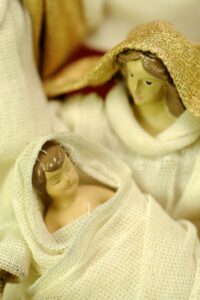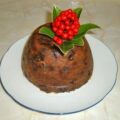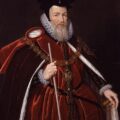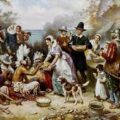
There was much celebration in England when Elizabeth I came to the throne. Elizabeth was a vibrant young woman replacing her half-sister Mary I who had been solemn and bitter and who had brought nothing but persecution, cruelty and hardship to England. Mary’s court had been solemn and serious whereas Elizabeth’s court was extravagant, luxurious and full of dancing and entertainment, and this carried over into the Christmas celebrations.
The Christmas Feast
Christmas was a time to “eat, drink and be merry”, a time to celebrate and enjoy a little luxury. Those families who could afford a Christmas feast would celebrate it in style with foods like roast goose, turkey or beef, and Brawn and Mustard (roast wild boar with mustard). Turkey had been eaten at Christmas by some people during Henry VIII’s reign, as it was introduced into England at that time, but it had not yet superseded goose which was still the traditional meat of Christmas Day for those who could afford it. In 1588, Elizabeth I ordered the whole of England to eat goose for their Christmas Dinner to celebrate England’s victory over the Armada because it was the first meal she ate after the Navy had defeated Spain’s ships.
Accompaniments to the roast meat included plum porridge, mince pies and frumenty, a pottage made from boiled, cracked wheat. The Christmas meal was washed down with beer, a popular drink in Tudor times when water was not fit to drink.
The following poem from 1573 gives us a good idea of the Elizabethan Christmas:-
Good husband and huswife, now chiefly be glad,
Things handsome to have, as they ought to be had.
They both do provide, against Christmas do come,
To welcome their neighbors, good cheer to have some.
Good bread and good drink, a good fire in the hall,
Brawn, pudding, and souse, and good mustard withal.
Beef, mutton, and pork, and good pies of the best,
Pig, veal, goose, and capon, and turkey well drest,
Cheese, apples and nuts, and good carols to hear,
As then in the country is counted good cheer.
What cost to good husband, is any of this?
Good household provision only it is:
Of other the like, I do leave out a many,
That costeth the husband never a penny.
Thomas Tusser, 500 Points of Husbandry, 1573
Richer households would have a more luxurious Christmas banquet which could include roasted swan or peacock which were displayed as table centrepieces with their feathers and skins put back on. A boar’s head may also be used as a table decoration. These centrepieces showed just how rich the householder was.
With the discovery of the New World and the Elizabethan voyages to America, the rich were also able to make use of new and exotic fruit and vegetables in their Christmas banquet. Tomatoes and potatoes were mixed with foods like citrus fruits which were specially imported from Southern European countries.
The Banqueting or Sweet Meat Course
This course was another way in which the host of the Christmas feast could flaunt their wealth, their status and their creativity. They would have already impressed their visitors with their roast meats and now they would use sweet delicacies to do the same.
Sugar was a luxury cooking ingredient in Tudor times and was rather expensive, so an array of sweet delicacies would impress the guests. Delicacies on display would have included:-
- Leech – A sweet made from milk, sugar and rose-water, which was cut into cubes. It was then displayed as a chequerboard, with some of the leech left plain and other cubes gilded.
- Collops of Bacon – A collop was a rasher of bacon but these collops were crafted from ground almonds and sugar, a bit like our present day marzipan.
- Sugar-plate – Sugar-plate was made from sugar, egg white and gelatin, and then crafted to look like walnuts, eggs and other food items.
- Gilded fruit – Fruit like lemons were gilded and used to decorate the banquet table.
- The Marchpane – This arrangement made from almond paste which was iced or gilded and then decorated with sugar figures and crystallised fruit, was the centrepiece of this course.
Other Christmas Food and Drink
As well as the roast meats and sweet delicacies, the well-to-do Elizabethans would have enjoyed:-
- Christmas pudding – A “pudding” made from meat, spices and oatmeal and then cooked in the gut of a boar
- Brussels Sprouts – The wonderful Brussels Sprout made its debut in England in the late 1580s.
- Gingerbread – Made from bread, ginger, spices, sugar and wine. This made a stiff paste which was then moulded.
- Mulled wine – Wine heated and infused with sugar and spices.
- Syllabub – A hot milk drink flavoured with rum or wine and spices
- Lambswool – A drink made from mixing hot cider, sherry or ale, apples and spices. The mixture was heated until it “exploded” and formed a white “woolly” head.
- Tarts and custards for dessert
- Quince marmalade
Humble Pie
The phrase “to eat humble pie” means to apologise or to face humiliation for your mistake or blunder, but it has its roots in Tudor and Medieval times when servants or lower-class people would use offal (kidneys, intestines, brain, heart or liver) and left-overs to make a pie. The “humbles” would be boiled in a stew with dried fruit, apples, suet, spices, sugar and salt, and then baked in pastry.
Christmas Traditions
Traditions enjoyed at Christmas in Tudor and Elizabethan times included:-
- The Lord of Misrule – A commoner would be chosen as “The Lord of Misrule” and would be in charge of organising the entertainment and revelry for the Twelve Days of Christmas.
- Mummer’s Plays with music and morris dancing
- Decorating with greenery – Holly, ivy and other winter greenery would be brought inside the homes to decorate it.
- The Yule Log – A Yule or Christmas log would be brought into the home on Christmas Eve and burned throughout the Twelve Days of Christmas. It was considered lucky to start the fire with the remains of last year’s Yule Log.
- Christmas Carols – Christmas carols were sung on Christmas Eve and Christmas morning around the parish and carollers would be rewarded with money, food or drink.
- Wassailing – The enjoying of a communal cup of spiced ail. Wassailing has also been linked to blessing the orchards and land, and going round the parish in groups with an empty bowl for householders to fill with spiced ale.
- Twelfth Day and Night – This was celebrated with a church service commemorating the coming of the Three Kings. A special cake would be baked and then given out to members of the family and household. This cake would contain a bean and whoever found it would be pronounced King of the Bean. This tradition still exists in countries like Spain, where a Roscon filled with cream and decorated with glace fruit is shared. This cake has little gifts and novelties mixed in with the cream and also contains a bean. Whoever finds the bean is crowned King with the crown that comes with the cake and is considered lucky.
You can find out more about Christmas in Tudor times in my article over at The Anne Boleyn Files – Tudor Christmas.
Sources
- Elizabethan Christmas
- Life in Elizabethan England
- BBC History – Ten Ages of Christmas
- An Elizabethan Christmas Feast
- “Pleasures and Pastimes in Tudor England” by Alison Sim
Merry Christmas!
I would just like to take this opportunity to wish you all a very Merry Christmas and a Happy New Year. Thank you so much for your support over the past few months and I hope that all your Christmas wishes come true. God Bless x



